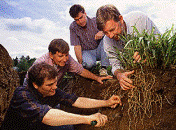United States Department of Agriculture: Agricultural Research Service, Lincoln, Nebraska

United States Department of Agriculture-Agricultural Research Service / University of Nebraska-Lincoln: Faculty Publications
Document Type
Article
Date of this Version
1997
Citation
Crop Sci 37:595-598
Abstract
Panicum virgatum L. (switchgrass) is perennial grass that is native to most of the USA. The principal use of switchgrass has been as a pasture and range grass for forage production during the warmer summer months. The objective of this research was to determine if DNA content and chloroplast DNA (cpDNA) polymorphisms existed among and within switchgrass accessions from Midwestern prairie sites. Twenty-eight switchgrass accessions from remnant prairie sites were surveyed in 1994 for the upland cytotype (U) or lowland (L) cytotype in the cpDNA by means of restriction endonuclease BamHI and sorghum cpDNA probe pLD 5. These accessions were also surveyed in 1994 for DNA content differences ltow cytometry. One accession, IA 31, contained a mixture of cytotypes indicating that both cytotypes can occur at a single remnant prairie site. The other Midwestern remnant prairies that were represented in this study contained only the U cytotype. The flow cytometry results indicated that switchgrass populations found within the Midwestern sites can be a mixture of ploidy levels with either 3 (tetraploid) or 6 (octaploid) pg DNA per cell. These results indicated that germplasm from Midwestern prairies should be identified according to DNA content and cytotype before it is utilized in developmental programs by plant breeders.


Comments
U.S. government work